In this article, we’re going to take a closer look at the Roborovski hamster. We’ll cover everything you need to know about this hamster breed. Things such as their origins, temperament, appearance, lifespan, and how to care for them will all be discussed in detail.
If you’ve decided that you want a hamster, I think you’re making a good choice. They’re awesome pets that can be a great addition to many homes. However, deciding you want a pet hamster is one thing. Deciding which breed you want is another.
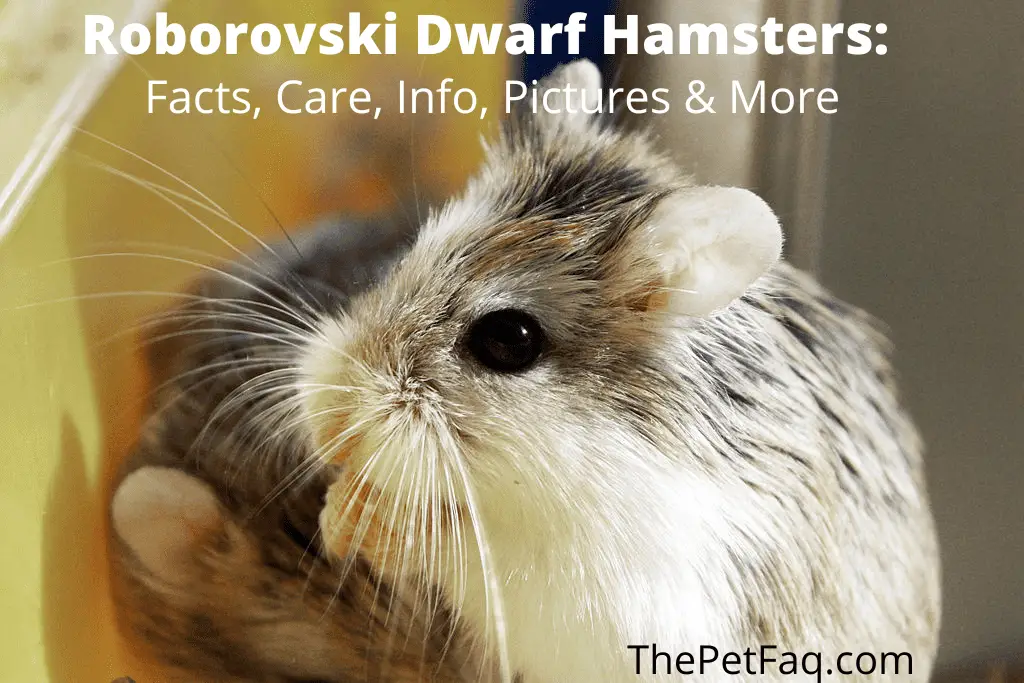
There are a total of 5 different hamster breeds that people keep as pets, all with their own unique personalities, appearances, and needs. Deciding which one is the best fit for you is not always easy. If you’re considering a Roborovski hamster, it’s essential that you know what you’re getting into. To help with that, we’re putting this hamster breed in the spotlight.
Roborovski hamsters, also known as Robo hamsters, are dwarf hamsters. Most Robo’s are docile animals that can get along well with humans, and sometimes even other Robo Hamsters! In addition, they’re relatively easy to care for and quite low-maintenance as far as pets go.
Keep reading to learn everything you need to know about the tiniest hamster breed: The Roborovski!
Roborovski Hamster Fact Sheet
| Name | Roborovski Hamster, also known as Robo, or Robo Dwarf Hamster |
| Length | 1.8 to 2 inches |
| Weight | 20 to 25 grams |
| Experience required | Intermediate |
| Lifespan | 2 to 4 years |
| Temperament | Shy, not as social as some other hamster breeds |
| Colors | Most commonly a sandy color, but many alternative colors are available such as white face, platinum, or mottled. |
| Alone or in pairs? | Most Robo hamsters do best alone. However, they can live in pairs if they’ve known each other since they were young. |
Origins of the Roborovski Hamster
The Roborovski Dwarf Hamster is a dwarf hamster native to the deserts of Central Asia. Because of their native habitat, they’re also known as the desert hamster.
They’re the smallest of all the dwarf hamsters, at a length of only 1.8 to 2 inches and a weight of only 20 to 25 grams.
These hamsters were first officially discovered by Russian explorer Vsevolod Roborovski, who found this new species in the desert. As you might have noticed, the person who discovered the breed has the same name as the hamster, that’s because he named them after himself.
An interesting fact about the Roborovski is that they’re extremely fast runners. They put that speed to good use because they can run up to 6 miles per night.
I say they run 6 miles per night, and not per day because these tiny rodents are nocturnal. Meaning that they’re active during the night and sleep for most of the day. They usually wake up around dusk and stay awake all throughout the night.
Temperament of the Roborovski
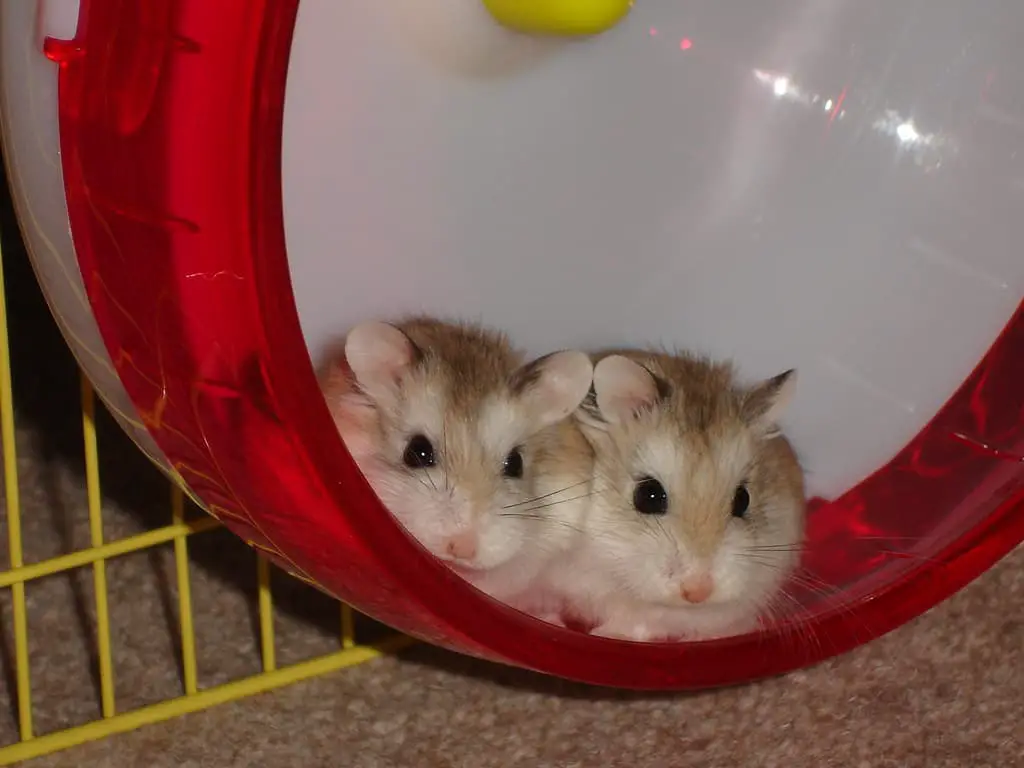
Robo hamsters are often described as being relatively low-maintenance. Of course, no pet is truly low maintenance. They all need love, attention, food, a clean cage, and good care, all of which take time and effort.
What people mean when they say that Roborovski hamsters are relatively low maintenance is that they’re not very demanding. They’re not very cuddly and most don’t even like being picked up all that much. Roborovski hamsters are not aggressive, but they are relatively easy to frighten and might bite if you startle them. This is understandable behavior, after all, they are prey animals and very small ones at that! They have much to fear from the world around them.
However, while Robo’s are not the cuddliest of the bunch, they are quite fun to watch! They can run around at high speeds and creating an obstacle course for your Robo is a lot of fun for both you and your hamster.
In addition, while Roborovski hamsters might not spend the night cuddled up on the couch with you, they can learn to love their owners. Many Robo’s come outside of hiding when they notice that their owner is nearby, especially if you come bearing gifts (treats).
It is recommended to keep Roborovksi Hamsters alone. They can be quite territorial and do not always get along well with other animals. However, it is possible for two Robos to live together if they’ve been together since they were young.
Roborovski Hamster Appearance 🐹
Roborovski hamsters are small. On average, they’re about 1.8 to 2 inches in length and weigh 20 to 25 grams. Baby Roborovskis are even smaller at less than 2 centimeters in length and 1 to 2 grams in weight.
Robos are characterized by eyebrow-like white spots on their body and the lack of a dorsal stripe, which is a stripe running along the spine, that other dwarf hamsters do have. They also have very long whiskers.
The Roborovski hamster is often sandy in color. This makes sense because it allows them to blend in with their native, desert, environment. Nevertheless, Roborovksi hamsters can have many different colors as well. Here is a complete list of all the colors and patterns that Roborovski hamsters can have:
- Agouti
- White face
- Husky
- Mottled
- Head spot
- Dark-eared white
- Black eyed white
- Red-eyed
- Black/blue
Caring for Roborovski Dwarf Hamsters
Caring for Roborovski Hamsters is relatively straightforward. As long as you provide them with love, a clean cage, grooming, good food, mental stimulation, and vet visits when they need it, they will be content.
Of course, in order to provide these things you do need to know what they are exactly. For instance, what is considered good food for a Roborovski? Let’s take a closer look at each individual aspect of caring for a Robo Hamster, shall we?
What do Roborovski Hamsters eat? 🥦
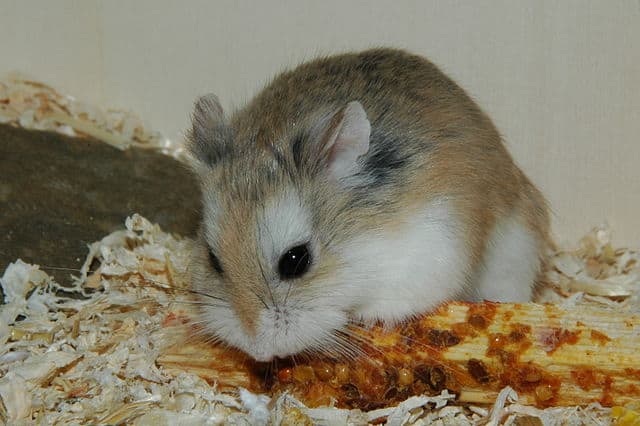
In the wild, Roborovskis eat a diet that consists primarily of seeds, nuts, grains, vegetables, fruit, and other plants. However, since they are omnivores, they can also eat meat and insects.
In captivity, they should eat much of the same as what they eat in the wild. The primary difference is that captive Robos should also eat pellets. These pellets are specifically created to contain everything that your Roborovksi needs to thrive.
So, the ideal diet for a Roborovksi hamster consists primarily of pellets, with smaller amounts of fresh fruits and vegetables. In addition, you can occasionally give them a small piece of meat or fish.
Some good vegetables and fruits to feed include:
- Cauliflower
- Kale
- Cucumber
- Celery
- Apples (no seeds)
Some fruits and vegetables to avoid include:
- Onions
- Garlic
- Hot peppers
- Citrus fruits
- Leafy parts of tomatoes
However, always make sure that the fruits and veggies you feed your hamster are only given as a small part of their diet. The vast majority of your Roborovski’s food intake should come from the pellets since they’re the most nutritionally complete food available for hamsters.
In addition to food, your hamster should also have access to clean water from a bottle or bowl 24/7.
Grooming Roborovksi Hamsters ✂️
Roborovksi hamsters are excellent at keeping themselves clean. They spend a lot of time grooming themselves so you do not need to spend a whole lot of time grooming them. As long as you provide them with a sand bath, they’ll do the rest!
One very important thing to note is that you shouldn’t give your hamster a water bath, even if you think they’re dirty. Putting your hamster in deep water will cause extreme panic and remove protective oils from its coat. If you do feel like you need to clean them a bit, use a shallow dish of lukewarm water, but only do this in rare, emergency situations.
One important thing that you do have to be careful about is your Robo’s teeth. Hamsters are rodents, which means that their teeth never stop growing. In order to keep their teeth under control, hamsters grind them down. Make sure that your Robo has access to plenty of chew toys.
Housing a Roborovski Hamster 🏠
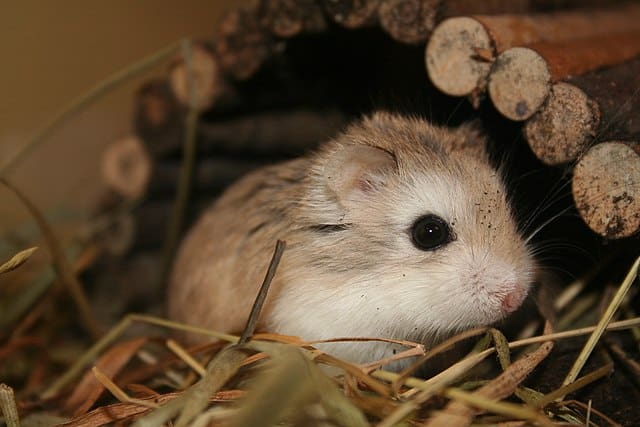
Roborovski hamsters may be small, but they still need a decent amount of space. They need a cage that’s a minimum of 0.5 square meters in size, or two feet long, one foot high, and one foot wide. However, for hamsters, a bigger cage is always better. Since Robo hamsters are not all that social, they will most likely spend quite a bit of time in their cage. It’s only fair that you give them a decently sized home!
Store-bought wire cages are okay for Robo hamsters and will allow them to climb on the wires. An important thing to take note of when buying a wire cage is the bar spacing. Bar spacing refers to the amount of space between the wires. Too big will allow your Robo to escape, while too small will prevent your hamster from climbing. Generally speaking, a bar spacing of 7mm is optimal for Robo hamsters.
An alternative to store-bought wire cages is an aquarium (without water, obviously). Many people use aquariums because they can hold more substrate. When using an aquarium, make sure that you do not completely cover the top, leave enough space open for ventilation.
Substrate
Roborovski hamsters have a natural urge to burrow, so they need quite a lot of substrate. Around 7 to 9 inches of substrate is often recommended. However, just like with cage size, a deeper layer of substrate can never hurt. This gives them plenty of space to burrow.
Good substrate material includes Aspen wood shavings or chemical/dye-free shredded paper. Of course, commercial hamster bedding is also an option.
Cage essentials
Here are the essential things that your hamster needs in its cage to feel at home:
- Food dish
- Water bottle or bowl
- Exercise Wheel
- Plenty of hiding spots
The reason why they need a food dish and water bowl/bottle speak for themselves; they need them to eat and drink! The exercise wheel they need because they’re very energetic little creatures. They need a way to release that pent-up energy, which a hamster wheel is ideal for.
The hiding spots are just as important. Robo hamsters are very small prey animals. They need plenty of hiding spots so that they feel safe and secure from the outside world.
Roborovski Hamster Lifespan
An important thing to know before buying any pet is its lifespan. It’s important to know this because it gives you an idea of how long of a commitment you’re taking on.
In the case of Roborovski hamsters, their lifespan is typically about 2 to 4 years in captivity, so not all that long.
Buying a roborovski Hamster
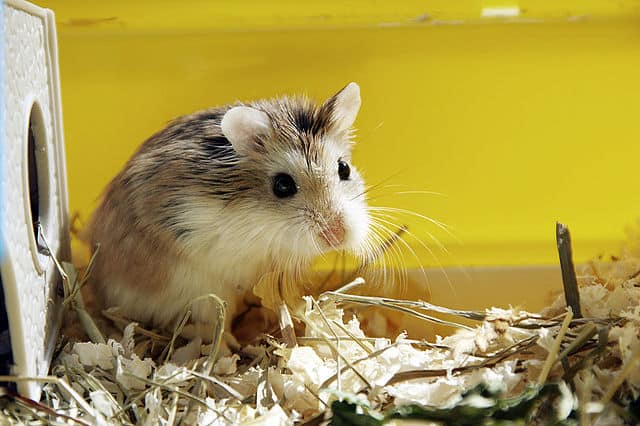
If after reading all of this you’ve decided that a Roborovski hamster is a great fit for you, congratulations! Now all that’s left to do is figure out how you can get your hands on one.
Roborovski hamsters can be bought from breeders or from pet shops. Rescuing one from a shelter is not often an option because these hamsters do not have a very long lifespan.
Buying from a breeder
Buying a Roborovski hamster from a breeder is the preferred option. Reputable breeders often take better care of the hamsters they sell and sell hamsters that are more socialized and in better health. In addition, breeders are often not in it just for the money, but because they actually love hamsters.
They will often be able to give you a lot of information about the animal and want to see it go to a loving home.
One nice thing about Roborovski hamsters is that they’re not very expensive, even from breeders. On average, breeders charge about $20 for a Robo.
Buying from a pet shop
Buying a hamster from a pet shop is not really recommended. They’re often less socialized and in worse health than those you buy from breeders. The only advantage of buying a hamster from a pet shop is that it’s cheaper and more convenient.
Monthly costs
While buying a Robo is very cheap, you have to take into account the monthly costs as well. On average, food, bedding, vet costs, and toys, will cost around $20 to $50 a month.
Frequently asked questions
Are Roborovski hamsters good pets?
While challenging, Roborovski hamsters can be good pets for experienced hamster owners. They’re not the most affectionate or cuddly and can be hard to tame. However, once you form a bond with them it can be a very rewarding relationship.
Do Roborovski hamsters like being held?
Roborovski hamsters do not enjoy being held very much. They’re not as social as other hamster breeds and prefer doing their own thing.
Do Roborovski hamsters bite?
Robos are generally not aggressive but they can bite when they feel scared. Make sure that you approach them calmly to avoid startling them.
Do Roborovski hamsters need to be in pairs?
Not necessarily. In the wild, they sometimes live in groups but they usually live alone. They might tolerate a cagemate if they’ve grown up with them, but they definitely do not need one to be happy.
Final words
By reading through this article you’ve learned everything there is to know about keeping a Roborovski hamster as a pet. You now know that while challenging, Robos can be a great fit for some people, as long as they know what they’re getting into. They’re definitely not the most beginner-friendly hamster breed, but it’s possible to form a rewarding bond with them as long as you treat them right.
If you’re interested in a more beginner-friendly hamster, the Syrian might be the best option for you. If dwarf hamsters are your thing, you might also want to consider the following breeds:
- How Long Do American Eskimo Dogs Live? Important Factors and Care Tips - September 29, 2023
- Do American Bulldogs Need Grooming? Essential Tips and Care Guidelines - September 29, 2023
- Do Bengal Cats Enjoy Playing? Essential Tips for Keeping Them Active - September 29, 2023